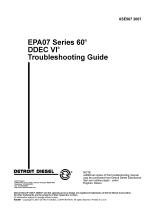
Auxiliary valve timeout (AVCTO).........................................................................................................................................48
Power save (OEM).....................................................................................................................................................................48
Spool curve................................................................................................................................................................................. 48
Float available (spool).............................................................................................................................................................49
Error codes........................................................................................................................................................................................49
1’s complement redundancy test.......................................................................................................................................49
1st boot ....................................................................................................................................................................................... 49
Reserved.......................................................................................................................................................................................49
Division by zero.........................................................................................................................................................................49
CapCom values .........................................................................................................................................................................49
Variable truncation...................................................................................................................................................................50
Verified write to cell error .....................................................................................................................................................50
Reserved.......................................................................................................................................................................................50
Interpolation check..................................................................................................................................................................50
Estimate calibration values error........................................................................................................................................ 50
PWM calibration values error .............................................................................................................................................. 50
Mechanical Spool Compensation values.........................................................................................................................51
Reserved.......................................................................................................................................................................................51
Spool data and Float available.............................................................................................................................................51
Reserved.......................................................................................................................................................................................51
Reserved.......................................................................................................................................................................................51
CRC16 check / Parameter memory.....................................................................................................................................51
Fall back to old values.............................................................................................................................................................52
CRC16 check / Program memory........................................................................................................................................52
Main spool cannot reach neutral from retract...............................................................................................................52
LVDT wiring error .....................................................................................................................................................................52
Power supply above specified range................................................................................................................................ 52
Power supply below specified range................................................................................................................................ 52
No answer on handshakes ................................................................................................................................................... 53
Power-on self test failed ........................................................................................................................................................53
Time value for CL control out of range.............................................................................................................................53
Main spool cannot reach neutral........................................................................................................................................53
Main spool cannot reach float position............................................................................................................................53
Main spool not in neutral at boot up.................................................................................................................................54
Main spool position is greater than the reference....................................................................................................... 54
Main spool position and reference are in opposite directions................................................................................ 54
Float threshold has not been passed................................................................................................................................ 54
Time guarding on Auxiliary Valve Command................................................................................................................ 54
Illegal CAN address ................................................................................................................................................................. 55
Command out of range .........................................................................................................................................................55
Scaling error ...............................................................................................................................................................................55
Ramps error ................................................................................................................................................................................55
Float threshold error ...............................................................................................................................................................55
Dead band compensation error .........................................................................................................................................55
Slope error ..................................................................................................................................................................................56
Shape error..................................................................................................................................................................................56
Invert port error ........................................................................................................................................................................56
Illegal combination of Port Flow Command and Blocked state..............................................................................56
Illegal combination of Port Flow Command and Float state....................................................................................56
Port flow command above 100%....................................................................................................................................... 56
Illegal valve state ......................................................................................................................................................................57
Illegal valve state and illegal port flow command........................................................................................................57
Illegal combination of inverted ports and float properties.......................................................................................57
Errors overview table...............................................................................................................................................................57
Service tool
Requirements..................................................................................................................................................................................59
PLUS+1
®
PVE Service Tool S4 DJ............................................................................................................................................... 59
Installation........................................................................................................................................................................................59
Use of service tool..........................................................................................................................................................................60
Technical Information
PVED-CC, Series 4 Electrohydraulic Actuator
Contents
520L0665 • Rev 0307 • October 2015 5
























